Kurayoshi City, Tottori Prefecture
Latter portion, Middle Yayoi (approximately 2,000 years ago)
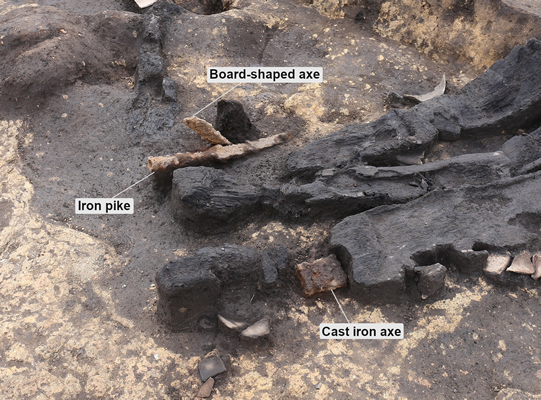
One iron pike and two iron axes recovered from a burned pit-structure The iron pike was found in a horizontal position near the base of a pillar, and is thought to have been planted standing upright. The board-shaped axe had the side for attaching a handle thrust into the pillar base, and its blade pointing upward. All of these are items for use by attaching a handle, but no handle could be discerned when they were discovered. From the lack of any traces of the items themselves being used, it is possible that they were not being utilized with handles for their conventional purposes. Adapted from Hakkutsu sareta Nihon rettō 2022 [Excavations in the Japanese Archipelago, 2022] (Bunkachō [Agency for Cultural Affairs], ed., Kyodo News, 2022).
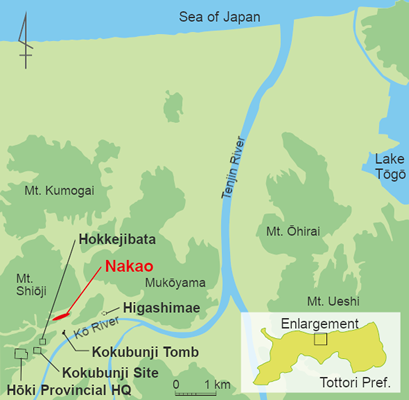
Location of the site Adapted from Hakkutsu sareta Nihon rettō 2022 [Excavations in the Japanese Archipelago, 2022] (Bunkachō [Agency for Cultural Affairs], ed., Kyodo News, 2022).

Iron pike, board-shaped iron axe, cast iron axe (from the left) The iron pike is the longest for Japan in the Yayoi period. It is similar to an iron pike (approximately 59 cm) recovered from the Tahori site in South Korea. Despite its great size, as the blade is thin it is not thought to have been for actual use. The board-shaped axe is of the largest class for Japan, and there are similar examples from the Korean sites of Tahori and Neukdo. The cast iron axe was made from a two-part mold.
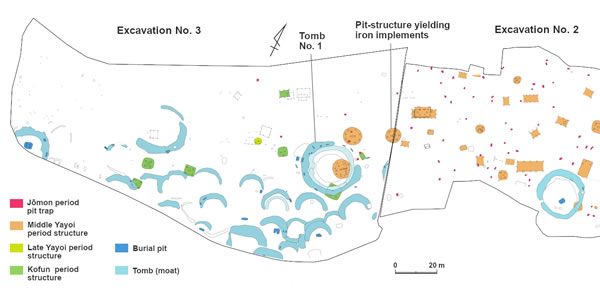
Plan of the entire site Adapted from Hakkutsu sareta Nihon rettō 2022 [Excavations in the Japanese Archipelago, 2022] (Bunkachō [Agency for Cultural Affairs], ed., Kyodo News, 2022).
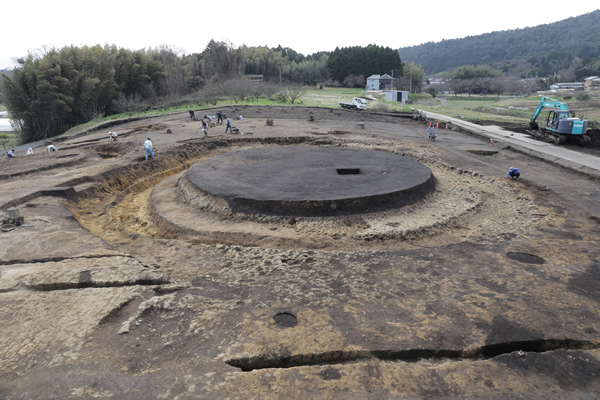
Tomb No. 1 The largest kofun (mounded tomb), at 22 m diameter, was encircled by 14 burial pits on its circumference.

Overall plan of the pit-structure that yielded iron implements Adapted from Hakkutsu sareta Nihon rettō 2022 [Excavations in the Japanese Archipelago, 2022] (Bunkachō [Agency for Cultural Affairs], ed., Kyodo News, 2022).
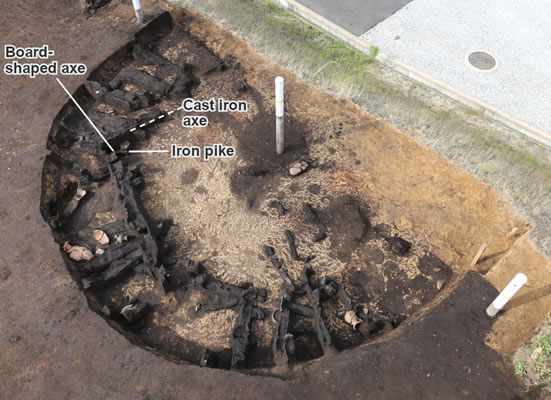
Pit-structure that burned down (western half) The eastern half was uncovered in excavation No. 2, and the western half investigated in excavation No. 3. Viewed from above, the placements of beams and rafters (the framework radiating out from the center to the lateral walls) can be readily seen. Adapted from Hakkutsu sareta Nihon rettō 2022 [Excavations in the Japanese Archipelago, 2022] (Bunkachō [Agency for Cultural Affairs], ed., Kyodo News, 2022).
Longest imported iron items for Japan recovered from a Yayoi settlement on the Sea of Japan
A strategic location where human activity continued from ancient times
The Nakao site is located in the city of Kurayoshi, in the central portion of Tottori Prefecture. It is situated atop a low hill in the Ōtani district of Kurayoshi, some 7 km south from the Japan Sea coast, and on the south side of the hill flows the Kō River, a branch of the Tenjin River. Concentrated in the vicinity are important sites of each historic period, such as the Hōki Provincial Headquarters and the Hōki Kokubunji (provincial monastery) Historic Sites, along with the Higashimae site and Kokubunji kofun (mounded tomb), giving evidence for the important role played by this area in former times.
In conjunction with the development of an industrial park, an excavation (No. 1) was conducted at the Nakao site in fiscal 1991, followed by another (No. 2) during the 2014–2016 fiscal years. As a result, stone tools of the Upper Paleolithic and 159 pit traps of the Jōmon period used for hunting, 25 pit-structures of the Yayoi period, 21 embedded-pillar buildings, and two mounded tombs of the Kofun period and so forth were discovered, from which it was seen that the location had long been a place of human activity. Also, in the excavation (No. 3) conducted during fiscal 2019–2021, 11 pit-structures from the Middle Yayoi to the Early Kofun periods, 25 tombs from the Middle to the Late Kofun period, and so forth were ascertained.
From a pit-structure of the latter half of the Middle Yayoi discovered in excavation No. 3, a complete iron socketed pike and two iron axes were recovered. The iron pike is thought to have been brought from the Korean peninsula, and at 54.3 cm in overall length is the longest example recovered from within Japan. The iron axes consist of a wrought item made by hammering iron into the shape of a board, and a cast item made by pouring molten iron into a mold, with the board-shaped axe seen as made on the Korean peninsula and of the largest size for such items in Japan at 27.5 cm in overall length, while the cast iron axe is regarded as of Chinese manufacture, and 11 cm in total length.
Iron implements appeared in the Japanese archipelago at the end of the Early Yayoi period, but even in the Middle Yayoi, iron implements brought from the continent or the Korean peninsula were extremely rare and precious. Finds of iron implements are mainly seen as grave goods from the burials of important figures in the northern portion of Kyushu, and there are no other examples in Japan for the Yayoi period of items such as iron pikes and axes being found together in a pit-dwelling as at the Nakao site.
Pit-structure set ablaze with iron implements left behind
The pit-structure where the iron implements were found was near the western edge of the settlement from the latter portion of the Middle Yayoi period. It was a circular shape of approximately 7.5 m diameter, with six postholes found for supporting the roof. The building, which was slightly large for a pit-structure of that time, is regarded as having burned down, and the carbonized framework and roofing materials had survived. The three iron implements were all found beneath the burnt and collapsed beams and roof. The iron pike was lying down, but originally it appeared to have been stood upside down near a pillar with the point thrust into the floor. The board-shaped iron axe was also found thrust into the base of the same pillar. The cast iron axe was found 50 cm distant from the posthole. No handle was found for any of these items.
From the conditions of recovery, the three iron implements are seen to have been inside the pit-structure at the time of the conflagration, but if the fire was accidental these valuable items should have been taken when evacuating the building. From this it is conceivable that these tree iron implements were deliberately left in the structure, and possibly burned along with it for some ceremonial or ritual purpose. There is no other example seen nationwide of burning a pit-structure with iron implements left inside.
Based on the results of this excavation, there are new discoveries that call for reconsideration of the thinking until now about the spread of iron implements, from the fact that at a time when northern Kyushu was the center of distribution of items brought from the continent, an iron pike and axes were found in far distant Tottori Prefecture, and were being held within the settlement by residents of the inland site of Nakao.
At a time when settlements in northern Kyushu had deep relations with the continent, and were conducting frequent exchanges, it is possible that settlements of the Japan Sea coast with which the Nakao site had connections obtained imported items from the continent or the Korean peninsula without using northern Kyushu as an intermediary, and this may be called vital knowledge for considering the route of iron implement distribution of the Yayoi period. Also, the recovery of these iron implements from a razed pit-structure provides new material for thinking about the nature and manner of utilization of iron implements at the time. (Kataoka Keisuke)

